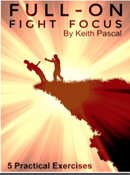Centerline Theory For Martial Arts
New Centerline Theory
by Keith Pascal
Rubberband Analogy Instead Broomsticks Through the Head
Simon wrote asking for more explaining of centerline principles.
I thought of one analogy that has nothing to do with poles down through the top of the head.
Take a rubber band.
Pinch it and hold it, so that one end of the band touches a wall.
With your other hand, pull back the other end of the rubber band.
You should have a straight line, from one hand to the other, along the band.
Now, let go of the back end of the rubber band. Snap! The band goes straight to the wall. BAM!
Wouldn’t it be great if all of our punches were this direct and this fast?
Change the Experiment
Now, let’s repeat the experiment … with a change”
Hold one end of the rubber band to the wall and pull the other end back.
This time, have someone push with a finger held straight on one side of the band or the other. Now, the band has a straight line from your back hand to your participant’s finger, and another line from the finger to the wall.
If you let go of the back again, what happens?
The band still hits the wall. It goes right around the finger and redirects on a straight line to the wall.
Imagine if, as soon as a finger interrupted the line of the band, the back end let go, and the band almost didn’t even pause … it just continued on a new straight line to the same spot on the wall.
What’s really cool about this analogy is that the finger could press into the rubber band from either side, from above the line of the band, or even from below.
Each time, the rubber band redirects right to the same spot.
And that, my friends. is an application of centerline theory.
Making Centerlines Practical
What?
You want me to make it practical?
OK …
A centerline master punches straight for the opponent’s body.
If the opponent blocks to the side, the punch just redirects, like a rubber band, and heads on in for the strike.
If the opponent blocks up, then the master’s hand drops down to its original path. If the opponent blocks down from above, then the master’s punch comes right over the top, back on course.
How’s that for practical application?
Tags: center-line, centerline theory, martial arts tactics, martial-arts visualization


